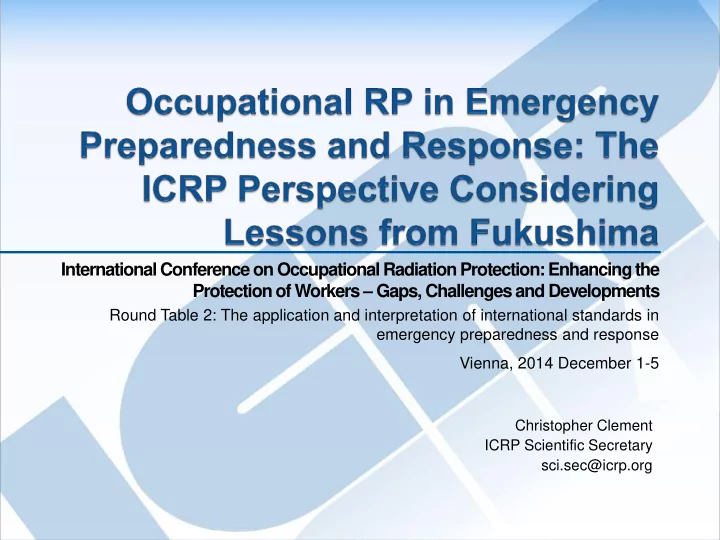

International Conference on Occupational Radiation Protection: Enhancing the Protection of Workers – Gaps, Challenges and Developments Round Table 2: The application and interpretation of international standards in emergency preparedness and response Vienna, 2014 December 1-5 Christopher Clement ICRP Scientific Secretary sci.sec@icrp.org
2
Response actions should be planned Possible emergency exposure situations can be assessed in advance (to some degree) However The exact nature of necessary protection measures cannot be known in advance but must flexibly evolve to meet actual circumstances 3
Roles should be identified in advance Radiation workers (e.g. employees of registrants and licensees) People not normally occupationally exposed e.g.: Police Rescue personnel Fire fighters Medical personnel Citizen volunteers 4
Exposure of responders is generally deliberate and controlled In principle , radiological protection should be consistent with that for planned exposure situations However, flexibility is required as there may be a need to take protective actions promptly, necessitating exposures higher than for planned exposure situations Nevertheless, doses should be optimised 5
Category 1: Engaged in urgent action at the site of the accident Acting to save life, or prevent serious injuries or a substantial increase in potential doses to members of the public Trained volunteers informed of the radiation risks Every effort to keep doses below where serious deterministic health effects may occur, i.e. 1 Sv effective dose or 5 Sv equivalent dose to skin For life-saving action higher doses may be justified 6
Category 2: Implementing early protective actions and taking action to protect the public Consistent with normal occupational exposure regime where feasible, with flexibility as required Category 3: Implementing recovery operations during the intermediate phase Subject to normal occupational exposure regime 7
“Women who have declared that they are pregnant, or who are nursing an infant, should not have an emergency role that would be expected to lead to doses greater than 1 mSv or to significant contamination” ICRP Publication 109 , paragraph 17 8
The system of occupational protection is not specifically tailored to workers who are not ‘radiation’ workers but who may be highly exposed e.g.: Rescuers that intervene in an accident People willingly taking risks for saving lives Volunteer workers / casual helpers in an emergency 9
Updating ICRP Publications 109 (emergencies) and 111 (post- accident recovery) Considering lessons from Fukushima and recent international developments on the protection of people in emergency exposure situations, and people living in long term contaminated areas after a nuclear accident or a radiation emergency An ongoing effort – expect public consultation in 2015/16 10
Considering protection of the various types of “ workers ” in various circumstances Plant personnel already considered radiation workers Emergency responders (fire fighters, medical personnel, other rescue workers) Off-site recovery workers employed by an authority or private company Volunteers in the recovery effort Homeowners and business owners working to improve their own properties 11
Considering protection of the various types of “workers” in various circumstances Different circumstances on-site and off-site may be stable with respect to further major off-site releases, with uncertainty on site where workers must contend with rapidly evolving conditions and potentially very high dose rates Different phases of emergency and recovery Different levels of preparation of responders prior to emergency 12
Workers who received > 100 mSv during an emergency “a high dose received in an accident should not necessarily preclude a worker from returning to radiation work” (ICRP Publication 63 paragraph A4) Clearer recommendations are being considered Level of detail of recommendations on medical follow-up is under discussion 13
3 rd International Symposium on the System of Radiological Protection October 20-22, 2015 Seoul, Korea ICRP Programme of Work Exploring Existing Exposure Situations Radiological Protection in Medicine Today The Science behind Radiation Doses New Developments in Understanding Radiation Effects Ethics in Radiological Protection 14
www.icrp.org
Recommend
More recommend